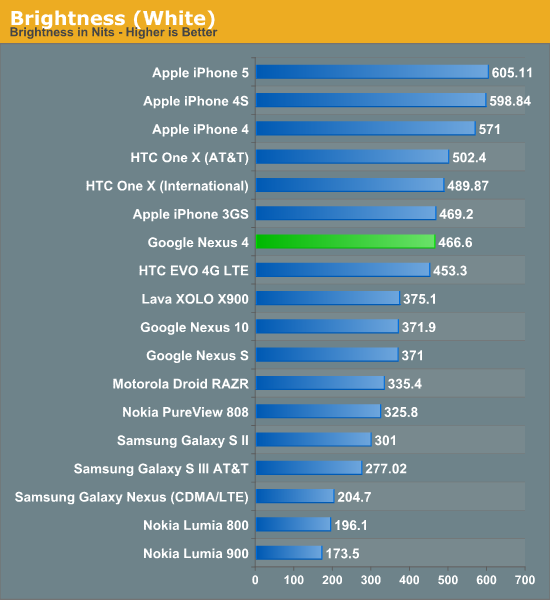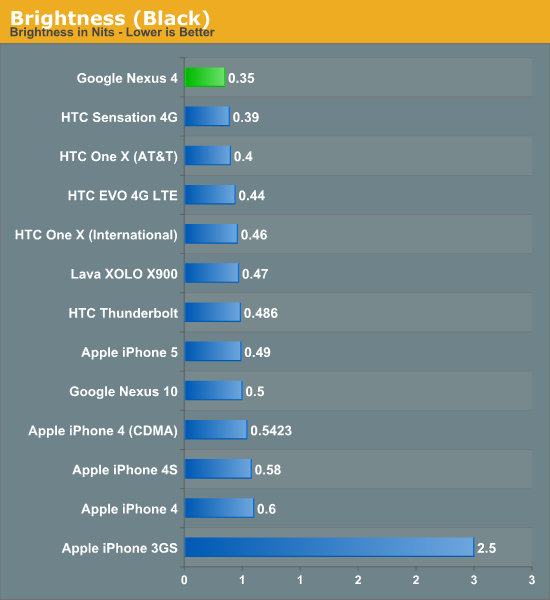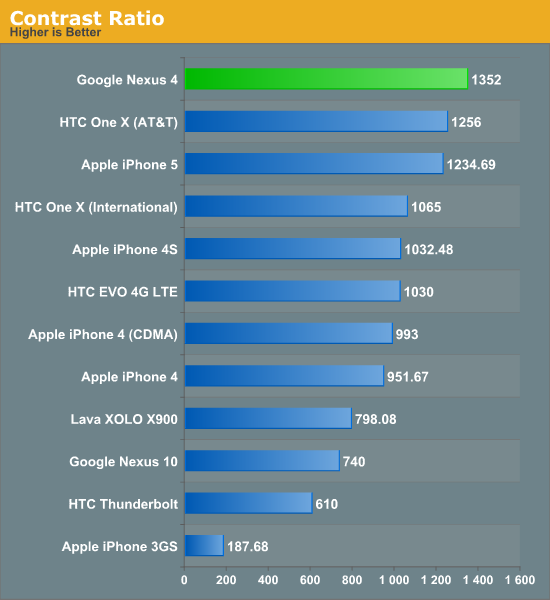Google Nexus 4 Review - Google's new Flagship
by Brian Klug on November 13, 2012 8:45 AM EST- Posted in
- Smartphones
- LG
- Android
- Mobile
- APQ8064
- Nexus 4
- Android 4.2
- MDM9215
The display on the Nexus 4 is another shared component between the Optimus G, and is a 4.7-inch IPS WXGA (1280x768) LCD, which is of course home to an RGB stripe and in-cell touch, or as LG calls it, "zerogap" touch. LG Display unsurprisingly knows how to make LCD displays, and the Nexus 4 display looks subjectively very good. At 320 PPI I can’t see any pixels, and don’t think we need to get into the whole visual acuity discussion again, it’s very good on the Nexus 4. The added width over straight 720p is something I noted was actually very refreshing on the Optimus G when playing with that device in Korea. Most apps scale appropriately and take advantage of it without any issue, and the extra width definitely is noticeable in Chrome, Plume, and all my daily drivers.



The Nexus 4 display goes very bright, at 466 nits, and achieves a contrast ratio of 1352:1 at that maximum brightness setting. This is a huge step over the barely 200 nits that the Galaxy Nexus could eek out.
| CalMAN Display Comparison | |||||||||
| Metric | iPhone 5 | iPhone 4S | HTC One X | Samsung Galaxy S 3 | Samsung Galaxy Note 2 | Google Nexus 4 | |||
| Grayscale 200nits Avg dE2000 | 3.564 | 6.162 | 6.609 | 4.578 | 5.867 | 7.686 | |||
| CCT Avg (K) | 6925 | 7171 | 5944 | 6809 | 7109 | 8506 | |||
| Saturation Sweep Avg dE2000 | 3.591 | 8.787 | 5.066 | 5.460 | 7.986 | 8.517 | |||
| GMB ColorChecker Avg dE2000 | 4.747 | 6.328 | 6.963 | 7.322 | 8.185 | 7.531 | |||
I’ve mentioned that Google continues to struggle at calibrating their displays. The truth is that everyone except for Apple, HTC, and occasionally Samsung, struggle at calibrating mobile displays. This continues to be the case with the Nexus 4, and the result is that accuracy could be better. I’m convinced the results that we’re getting out of the Nexus 4 basically represent no attempt at calibrating the display, and as a result the numbers suffer.
















188 Comments
View All Comments
Rits - Tuesday, November 13, 2012 - link
Mean nothing in real life. The N4 flies through tasks in practical usage. Bring me an iPhone5 and show me how it is faster in any way. Synthetic benchmarks are, for the most part, useless. Esp, cross-platform ones.PeteH - Tuesday, November 13, 2012 - link
Depends. In most cases I agree with you, but if you're interested in a phone capable of, for example, playing state of the art (for a mobile device) games, certain graphical benchmarks are useful.Granted most users won't care about that, but most users don't read AnandTech.
lilmoe - Wednesday, November 14, 2012 - link
The iPhone 5 isn't faster, its software is more optimized. Chrome is well known to really "suck" in javascript and scrolling performance on Android. Even Dolphin Browser beats it in each performance category. Samsung's stock browser on the SGS3 is probably the best Android browser out there, I wonder how well it would perform on the Nexus 4's CPU. Chrome is nice for syncing bookmarks across all your devices in addition to some stuff, but otherwise, it really sucks.In the GPU benchmark tests where the A6 (PowerVR SGX543 MP3) beats the APQ 8064 (Snapdragon S4 Pro's Adreno 320), These are sub-scores (sub-tests) that don't really show the "big picture". They test the GPU of the platform for several shader-centric tasks. Those who use these benchmarks are looking for specific numbers for specific purposes.
What really matters in GLBenchmark for most consumers is the "Egypt Classic" and "Egypt HD" tests. These tests show the gaming/GPU performance of the platform as a whole, with the former testing "generic" 3D gaming capabilities, and the latter testing for the most modern demanding games (that stresses the platform/shaders for most fillrate, vertex, and compute performance. It's mostly over-kill and you wont see games demanding the same anytime soon). You'll easily achieve 60fps with any game you run on the Nexus 4 even with a higher resolution than the iPhone 5...
The Nexus 4 should prove to be better performing and more "future-proof" than the iPhone 5, since it has a faster CPU (quad core Krait VS dual core Swift) and a GPU that supports future standards like OpenGL ES 3.0, Open CL and Renderscript, unlike the PowerVR inside the A6 chip. Software optimization is a non-issue since it can be tuned-up in future updates or different browsers from Play Store in the case of the web browser.
There are lots of metrics to consider in cross-platform/cross-OS benchmarking, and there's absolutely NO benchmark that will show the true difference of performance among different platforms, especially with "Android VS Android" or "Android VS iOS" because each Android OEM utilizes different hardware and different software optimizations (in addition to other factors, like thermal throttling in this review's case). That's probably not the case when comparing the iPhone 5 versus the 4S or even a Windows Phone 8 devices versus another device running the same OS because both platforms use vertically integrated hardware/software, but that's where firmware and driver version differences start to kick in, but it's closer to reality than anything related to Android.
Red Oak - Tuesday, November 13, 2012 - link
And also, no LTE. Comical. Certainly for the US marketantef - Tuesday, November 13, 2012 - link
Not at half the price of other phones. Also Android and especially Nexus is an open platform, so that automatically shuts the door on CDMA and consequently the biggest LTE carrier in the US. Nobody who has good HSPA+ cares.Penti - Tuesday, November 13, 2012 - link
In Europe you get pretty good carrier support with just quad band LTE which is showing up now. All USIM, plus Band 7, Band 20, Band 8, Band 3 covers most here and is available in most countries. In Sweden we started on Band 7 and now runs networks at Band 20 and Band 8 too. So we can actually get devices now which runs on all the frequencies either in use or that will be refarmed. Similar in other countries here. Most carriers has a few bands. You do need to support more then one. More troublesome in the US obviously. It is looking up finally though. DC-HSPA+ is up an running too so, even in small communities. It's not bad, at least not if you are able to use wifi for heavier/larger stuff.antef - Tuesday, November 13, 2012 - link
Clearly the Nexus 4 is not named as such because it's the 4th Nexus phone like you mention. If that was the case the Nexus 7 and 10 would throw a wrench in that wouldn't it? It's named that way because the screen is 4(.7)". If you look at the Nexus logo on the site they even de-emphasize the number by making it a small superscript to "nexus" and saying "now in three sizes." The fact that it's the 4th Nexus is just a coincidence. I would expect them to keep these names going forward and just release a Nexus 4 2nd gen, 3rd gen, etc.Rits - Tuesday, November 13, 2012 - link
Correct.tarunactivity - Tuesday, November 13, 2012 - link
The iPhone 5 resolution is 1136x640-pixel , not 1136x960 ...http://www.apple.com/iphone/specs.html
stotticus - Tuesday, November 13, 2012 - link
Of what city are those pictures?